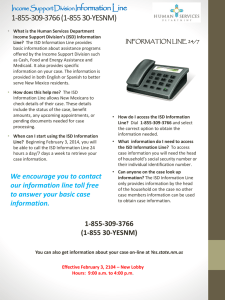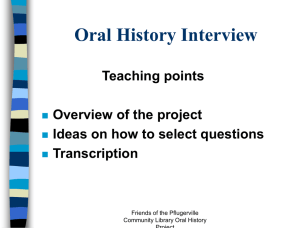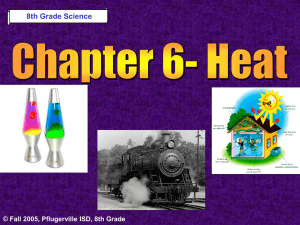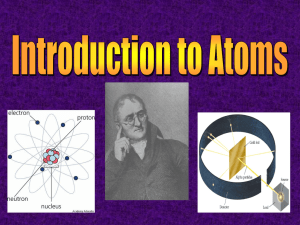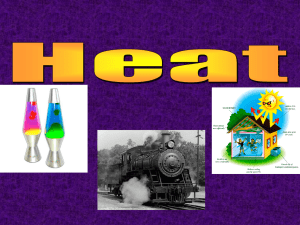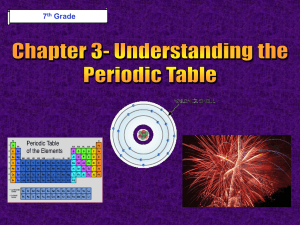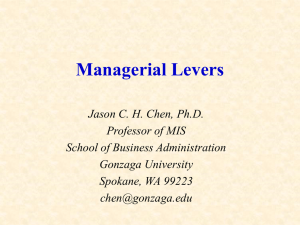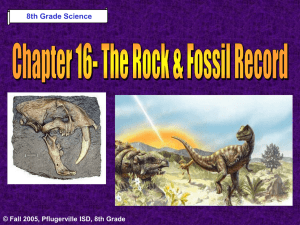Fall 2005, Pflugerville ISD, 8th Grade 8th Grade Science
advertisement
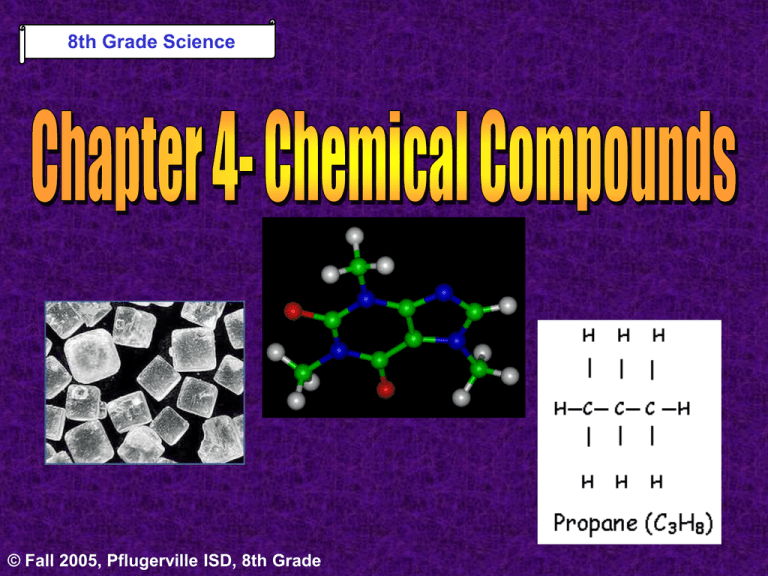
8th Grade Science © Fall 2005, Pflugerville ISD, 8th Grade Chapter 4- Chemical Compounds Section 1: Ionic Compounds Section 2: Covalent Compounds Section 3: Acids, Bases, & Salts © Fall 2005, Pflugerville ISD, 8th Grade Unit A : Chapter 1 : Section 1 What is a chemical compound? What Do You Think? Imagine that you need to attach two pieces of paper together. What are three ways you might do this? © Fall 2005, Pflugerville ISD, 8th Grade Unit A : Chapter 1 : Section 1 Chemical Bonds Terms to Know: • Valence Electrons • Ionic Compounds -Ions -Crystal Lattice • Covalent Compounds -Molecule © Fall 2005, Pflugerville ISD, 8th Grade Unit A : Chapter 1 : Section 1 Ionic Bonding • Ionic bonds are the forces of attraction between positive and negative ions • They are formed when atoms lend or borrow electrons from each other © Fall 2005, Pflugerville ISD, 8th Grade Unit A : Chapter 1 : Section 1 Ionic Bonding • Metals lend electrons • Nonmetals borrow electrons • Ionic compounds usually involve a metal and a nonmetal © Fall 2005, Pflugerville ISD, 8th Grade Unit A : Chapter 1 : Section 1 Na & Cl bond to form NaCl, or salt • Na has 1 valence electron in its outermost energy level • Cl has 7 valence electrons © Fall 2005, Pflugerville ISD, 8th Grade Unit A : Chapter 1 : Section 1 Na & Cl bond to form NaCl, or salt • Na lends one electron to Cl • Na becomes positive and Cl becomes negative • Salt ions are formed! © Fall 2005, Pflugerville ISD, 8th Grade Unit A : Chapter 1 : Section 1 Metal and Nonmetal Ions bond to form a Crystal Lattice • A crystal lattice is a 3-D, repeating pattern of ions • Ions are arranged by alternating positive and negative charges © Fall 2005, Pflugerville ISD, 8th Grade Unit A : Chapter 1 : Section 1 Properties of Ionic Compounds • Very high melting points • Brittle– break along planes of cleavage • Dissolve well in water • Water solution will conduct electricity © Fall 2005, Pflugerville ISD, 8th Grade Unit A : Chapter 1 : Section 1 Ionic bonds, revisited • Charged ions bond to form a neutral compound • Ionic bonds are the strongest type of bond • The number of valence electrons in an atom determines its reactivity with other elements © Fall 2005, Pflugerville ISD, 8th Grade Unit A : Chapter 1 : Section 1 Covalent Bonding • Covalent bonds are formed between nonmetals only • In a covalent bond, atoms share valence electrons © Fall 2005, Pflugerville ISD, 8th Grade Unit A : Chapter 1 : Section 1 Covalent Bonding • Valence electrons are weakly bonded to the nucleus • This weak attraction between the nuclei and the shared electron(s) binds the molecule © Fall 2005, Pflugerville ISD, 8th Grade Unit A : Chapter 1 : Section 1 O and H bond to form H2O • Oxygen has 6 valence electrons • Hydrogen has 1 valence electron © Fall 2005, Pflugerville ISD, 8th Grade Unit A : Chapter 1 : Section 1 O and H bond to form H2O • Oxygen needs 2 valence electrons for a stable shell • Hydrogen needs 1 valence electron for a stable shell © Fall 2005, Pflugerville ISD, 8th Grade Unit A : Chapter 1 : Section 1 O and H bond to form H2O • 1 Oxygen bonds with 2 atoms of Hydrogen and all 3 share the electrons • As long as the electrons are shared, valence shells are full © Fall 2005, Pflugerville ISD, 8th Grade Unit A : Chapter 1 : Section 1 Nonmetals bond to form Molecules • The simplest type of molecule is diatomic, meaning it is made of only 2 atoms • There are only seven elements that are diatomic: Hydrogen, Oxygen, Nitrogen, Fluorine, Chlorine, Bromine, and Iodine © Fall 2005, Pflugerville ISD, 8th Grade Unit A : Chapter 1 : Section 1 Nonmetals bond to form Molecules Caffeine Molecule © Fall 2005, Pflugerville ISD, 8th Grade • Molecules can get more complex, involving many different elements • Remember, covalent compounds contain only nonmetals Unit A : Chapter 1 : Section 1 Properties of Covalent Compounds • Low melting points • Most covalent compounds do not dissolve in water (oil & water don’t mix) • If it can dissolve, the solution does not conduct electricity © Fall 2005, Pflugerville ISD, 8th Grade Unit A : Chapter 1 : Section 1 Covalent bonds, revisited • Nonmetals only • Form uncharged molecules, not charged ions • Covalent bonds are the weakest type of bond © Fall 2005, Pflugerville ISD, 8th Grade Unit A : Chapter 1 : Section 1 Bonding & Compounds- Quick Quiz • How does a molecule form? • Which is stronger, an ionic or a covalent bond? • What is an ion? • Which type of bond typically has a higher melting point? • Which type of bond involves only nonmetals? © Fall 2005, Pflugerville ISD, 8th Grade Unit A : Chapter 1 : Section 1 What is a chemical compound? What Do You Think? Lemons and tomatoes have a tangy taste because they contain citric acid. What are some other foods that might be flavored by acids? © Fall 2005, Pflugerville ISD, 8th Grade Unit A : Chapter 1 : Section 1 What is an Acid? All of these products contain Acids © Fall 2005, Pflugerville ISD, 8th Grade Unit A : Chapter 1 : Section 1 What is an Acid? •HCl dissolves in water because it is an ionic compound •HCl breaks apart to form H+ ions and Cl- ions HCl is added to H2O © Fall 2005, Pflugerville ISD, 8th Grade Unit A : Chapter 1 : Section 1 What is an Acid? •The H+ ions bond with H2O to form H3O+, a hydronium ion HCl is added to H2O © Fall 2005, Pflugerville ISD, 8th Grade Unit A : Chapter 1 : Section 1 What is an Acid? •An acid is any compound that increases the number of H+ ions when dissolved in water •These H+ ions bond with the water to create H3O+, the hydronium ion •Strong acids are corrosive, meaning they can destroy clothing and body tissues © Fall 2005, Pflugerville ISD, 8th Grade Unit A : Chapter 1 : Section 1 What is a Base? All of these products contain Bases © Fall 2005, Pflugerville ISD, 8th Grade Unit A : Chapter 1 : Section 1 What is a Base? •Like other bases, NaOH is an ionic compound NaOH is added to H2O © Fall 2005, Pflugerville ISD, 8th Grade •NaOH dissolves in H2O and breaks apart to form Na+ ions and OH- ions Unit A : Chapter 1 : Section 1 What is a Base? •Strong bases will break apart completely to form lots of OH- ions, which are corrosive NaOH is added to H2O © Fall 2005, Pflugerville ISD, 8th Grade Unit A : Chapter 1 : Section 1 What is a Base? •A base is any compound that increases the number of OH-, or hydroxide, ions when dissolved in water •Strong bases, like strong acids, are corrosive, meaning they can destroy clothing and body tissues © Fall 2005, Pflugerville ISD, 8th Grade Unit A : Chapter 1 : Section 1 What is a Salt? All of these products contain a Salt © Fall 2005, Pflugerville ISD, 8th Grade Unit A : Chapter 1 : Section 1 What is a Salt? •When you hear the word salt, you probably think of table salt NaCl, or Salt Crystals © Fall 2005, Pflugerville ISD, 8th Grade •But salts are any ionic compounds formed from the positive ion of a base and the negative ion of an acid Unit A : Chapter 1 : Section 1 What is a Salt? •The from the base and the Cl from the acid bond to form NaCl, salt + Na © Fall 2005, Pflugerville ISD, 8th Grade Unit A : Chapter 1 : Section 1 What is a Salt? •The from the acid and the OH from the base bond to form H2O, water + H © Fall 2005, Pflugerville ISD, 8th Grade Unit A : Chapter 1 : Section 1 What is a Salt? •A salt is an ionic compound formed from the positive ion of a base and the negative ion of an acid •Salts are used to season our foods, make soap, treat our pools, and settle our stomachs © Fall 2005, Pflugerville ISD, 8th Grade Unit A : Chapter 1 : Section 1 Let’s Review! -1- What is the difference between ionic compounds and covalent compounds? © Fall 2005, Pflugerville ISD, 8th Grade Unit A : Chapter 1 : Section 1 Let’s Review! -2- What is an acid? What is a base? What is a salt? How are they all related? © Fall 2005, Pflugerville ISD, 8th Grade Unit A : Chapter 1 : Section 1 Chemical Compounds •http://www.ausetute.com.au/namiform.html •http://www.elmhurst.edu/~chm/vchembook/144 Acovalent.html •http://www.sciencebyjones.com/acids_bases_s alts.htm © Fall 2005, Pflugerville ISD, 8th Grade Unit A : Chapter 1 : Section 1 Pre-AP Extensions © Fall 2005, Pflugerville ISD, 8th Grade Unit A : Chapter 1 : Section 1
